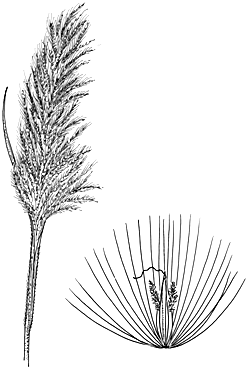Common name: Sugarcane
Saccharum officinarum L. APNI* 
Description: Tufted perennial to 6 m high; culms erect, to 4 cm diam., with prominent leaf scars, axillary bud and root ring above each node.
Leaves with orifice silky with hairs 3–7 mm long; ligule membranous, triangular, 4–5 mm long, apex obtuse, erose; blade to 3 cm wide.
Inflorescence 40–55 cm long, to 20 cm wide; rachis scabrous or smooth; axils silky with hairs to 0.5 mm long. Peduncle silky with hairs c. 0.5 mm long. Spikelets 3–4 mm long, borne in pairs, 1 sessile and 1 pedicellate, each spikelet subtended by a ring of silky hairs 4–12 mm long; florets 2, the lower floret sterile, the upper floret bisexual. Lower glume c. 4 mm long, upper margin sometimes with hairs < 0.5 mm long; upper 3.5–4 mm long, glabrous, upper margin often with hairs < 0.5 mm long. Upper sterile lemma 2.5–4 mm long; palea absent. Upper bisexual lemma absent; palea linear, 1.5–3.5 mm long.
Flowering: not common outside the tropics.
Distribution and occurrence: Cultivated and sometimes persistent after cropping and on stream banks.
NSW subdivisions: *NC
Other Australian states: *Qld
There are a large number of cultivars of S. officinarum, mostly of hybrid origin and not found as naturalized plants.
Text by S. W. L. Jacobs & K. L. McClay
Taxon concept: Flora of NSW 4 (1993)
APNI* Provides a link to the Australian Plant Name Index (hosted by the Australian National Botanic Gardens) for comprehensive bibliographic data
***The AVH map option provides a detailed interactive Australia wide distribution map drawn from collections held by all major Australian herbaria participating in the Australian Virtual Herbarium project.
|


